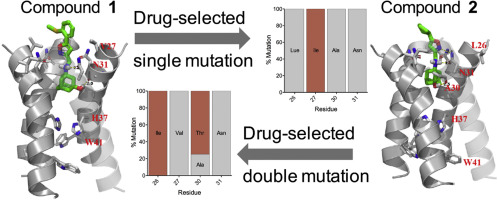Antiviral Research ( IF 4.5 ) Pub Date : 2018-03-06 , DOI: 10.1016/j.antiviral.2018.03.002 Rami Musharrafieh , Chunlong Ma , Jun Wang

|
The majority of human influenza A viruses currently in circulation carry the amantadine-resistant AM2-S31N channel mutation. We previously discovered a series of AM2-S31N inhibitors with potent antiviral activity against both oseltamivir-sensitive and -resistant influenza A viruses. To understand the drug-resistance mechanism of AM2-S31N inhibitors, we performed serial viral passage experiments using the influenza virus A/California/07/2009 (H1N1) to select drug-resistant AM2 mutations against two representative AM2-S31N channel blockers (1 and 2). Unlike amantadine, which gives rise to resistance after a single passage, compounds 1 and 2 selected for partially resistant viruses at passages 05 and 04 with a V27I and L26I mutation, respectively. This appears to suggest compounds 1 and 2 have a higher genetic barrier to resistance than amantadine at least in cell culture. Passage with a higher drug concentration of compound 2 selected higher level resistant viruses with a double mutant L26I + A30T. The mechanism of resistance and replication fitness for mutant viruses were evaluated by electrophysiology, reverse genetics, growth kinetics, and competition assays. AM2-S31N/V27I and AM2-S31N/L26I channels achieved similar specific proton conductance as AM2-S31N, but the AM2-S31N/L26I/A30T triple mutant had drastically reduced specific proton conductance. Viral replication fitness of AM2-S31N/V27I and AM2-S31N/L26I double mutant viruses were similar to AM2-S31N containing viruses in cell culture. However, AM2-S31N/L26I/A30T viruses displayed attenuated growth as well as inability to compete with AM2-S31N viruses. The results herein offer insight regarding the resistance mechanism of AM2-S31N inhibitors, and may help guide the design of the next-generation of AM2-S31N inhibitors with a higher genetic barrier to drug resistance.
中文翻译:

分析甲型流感病毒对AM2-S31N质子通道阻滞剂的体外耐药机制
当前正在传播的大多数人类甲型流感病毒带有耐金刚烷胺的AM2-S31N通道突变。我们先前发现了一系列具有AM2-S31N抑制剂,对奥司他韦敏感和耐药A型流感病毒均具有有效的抗病毒活性。为了了解AM2-S31N抑制剂的耐药机制,我们使用流感病毒A / California / 07/2009(H1N1)进行了一系列病毒传代实验,以针对两种代表性的AM2-S31N通道阻滞剂选择耐药AM2突变(1和2)。与金刚烷胺单次通过后会产生耐药性不同,化合物1和2在第05和04代分别选择具有V27I和L26I突变的部分耐药病毒。这似乎暗示化合物1和2至少在细胞培养中比金刚烷胺具有更高的抗性遗传壁垒。化合物2的药物浓度较高时通过选择了具有双突变L26I + A30T的更高水平的抗药性病毒。通过电生理,反向遗传学,生长动力学和竞争测定法评估了突变病毒的抗性和复制适应性的机制。AM2-S31N / V27I和AM2-S31N / L26I通道实现了与AM2-S31N相似的比质子电导,但是AM2-S31N / L26I / A30T三重突变体大大降低了比质子电导。AM2-S31N / V27I和AM2-S31N / L26I双重突变病毒的病毒复制适应性类似于细胞培养中含AM2-S31N的病毒。但是,AM2-S31N / L26I / A30T病毒显示出减毒的生长以及无法与AM2-S31N病毒竞争。本文的结果提供了有关AM2-S31N抑制剂耐药机制的见解,











































 京公网安备 11010802027423号
京公网安备 11010802027423号